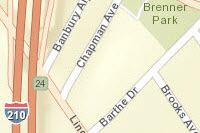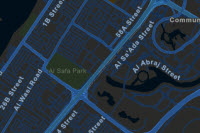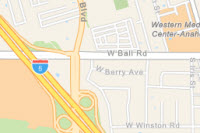WebMap
require(["esri/WebMap"], function(WebMap) { /* code goes here */ });esri/WebMapLoads a WebMap from ArcGIS Online or ArcGIS Enterprise portal into a MapView. It defines the content, style, and bookmarks of your webmap, and it can be shared across multiple ArcGIS web and desktop applications. The webmap is saved as a JSON document that can be consumed by the ArcGIS API for JavaScript via the WebMap class to easily create compelling 2D applications. The JSON document is written according to the webmap specification. Although you can easily create your own webmaps, there are many sample webmaps in ArcGIS Online that you can use to get started with the API. You may modify or add new content to these webmaps.
To load a WebMap from ArcGIS Online into a MapView, you must reference the ID of the webmap in the portalItem property of this class.
var webmap = new WebMap({
portalItem: { // autocasts as new PortalItem()
id: "e691172598f04ea8881cd2a4adaa45ba"
}
});
To load a Webmap from an on-premise portal, set the portal url in esriConfig.portalurl.
esriConfig.portalUrl = "https://myHostName.esri.com/arcgis";
var webmap = new WebMap({
portalItem: { // autocasts as new PortalItem()
id: "f701172599f04ea8781de2a4adzz46ab"
}
});
Then you must reference the WebMap instance in the map property of the view.
var view = new MapView({
map: webmap, // The WebMap instance created above
container: "viewDiv"
});
Known Limitations
- WCS and WFS layers are currently not supported.
In instances when the webmap contains layer types that are not yet supported in the API, layers will be created as an UnsupportedLayer. This layer type is used specifically in these instances where the layer may exist in a given WebMap (e.g. WFS layer), but may not be currently supported in the version of the API accessing it.
An UnknownLayer will be used if future versions of the WebMap contains a new type of layer. The API version may not recognize this layer type, therefore it would come across as an UnknownLayer.
- See also:
Constructors
- new WebMap(properties)
- Parameter:properties Objectoptional
See the properties for a list of all the properties that may be passed into the constructor.
Example:// Typical usage var map = new WebMap({ portalItem: { id: "e691172598f04ea8881cd2a4adaa45ba" } });
Property Overview
| Name | Type | Summary | Class | |
|---|---|---|---|---|
| Collection<Layer> | A flat collection of all the layers in the map. more details | more details | Map | |
| ApplicationProperties | The applicationProperties contains the viewing properties of the WebMap. more details | more details | WebMap | |
| String | The name of the application that authored the WebMap. more details | more details | WebMap | |
| String | The version of the application that authored the WebMap. more details | more details | WebMap | |
| Basemap | Specifies a basemap for the map. more details | more details | Map | |
| Collection<Bookmark> | An array of saved geographic extents that allow end users to quickly navigate to a particular area of interest. more details | more details | WebMap | |
| String | The name of the class. more details | more details | Accessor | |
| Ground | Specifies the surface properties for the map. more details | more details | Map | |
| InitialViewProperties | The initial view of the WebMap. more details | more details | WebMap | |
| Collection<Layer> | A collection of operational layers. more details | more details | Map | |
| Boolean | Indicates whether the instance has loaded. more details | more details | WebMap | |
| Error | The Error object returned if an error occurred while loading. more details | more details | WebMap | |
| String | Represents the status of a load operation. more details | more details | WebMap | |
| PortalItem | The portal item from which the WebMap is loaded. more details | more details | WebMap | |
| Object | Provides multiple slides. more details | more details | WebMap | |
| Object | The version of the source document from which the WebMap was read. more details | more details | WebMap | |
| Object[] | An array of table objects in the WebMap. more details | more details | WebMap | |
| String | The URL to the thumbnail used for the webmap. more details | more details | WebMap | |
| Object | The widgets object contains widgets that should be exposed to the user. more details | more details | WebMap |
Property Details
A flat collection of all the layers in the map. This collection contains basemap layers, operational layers and ground layers. Group Layers and their children layers are also part of this collection. Reference layers in the basemap will always be included at the end of the collection.
Layers should not be added directly to this collection. They must only be added via the layers, basemap or ground properties.
Example:// Find a layer with title "US Counties" var foundLayer = map.allLayers.find(function(layer) { return layer.title === "US Counties"; }); // Create a filtered collection of the non-group layers var nonGroupLayers = map.allLayers.filter(function(layer) { return !foundLayer.layers; }); // Listen for any layer being added or removed in the Map map.allLayers.on("change", function(event) { console.log("Layer added: ", event.added); console.log("Layer removed: ", event.removed); console.log("Layer moved: ", event.moved); });
- applicationProperties ApplicationPropertiesSince: ArcGIS API for JavaScript 4.14
The applicationProperties contains the viewing properties of the WebMap.
- authoringApp StringSince: ArcGIS API for JavaScript 4.14
The name of the application that authored the WebMap.
- authoringAppVersion StringSince: ArcGIS API for JavaScript 4.14
The version of the application that authored the WebMap.
Specifies a basemap for the map. The basemap is a set of tile layers that give geographic context to the MapView or SceneView and the other operational layers in the map.
This value can be an instance of Basemap or one of the strings listed in the table below.
Example:// Set the basemap in the constructor var map = new Map({ basemap: "streets" }); // Set the basemap after the map instance is created map.basemap = "topo";
- bookmarks Collection<Bookmark>autocast
An array of saved geographic extents that allow end users to quickly navigate to a particular area of interest.
- Since: ArcGIS API for JavaScript 4.7
The name of the class. The declared class name is formatted as
esri.folder.className.
Specifies the surface properties for the map. This property is only relevant when adding the map to a 3D SceneView. It renders the terrain or topographical variations in the real world on the map's surface with a collection of ElevationLayer.
This value can be an instance of Ground, or one of the following strings:
world-elevationfor a default instance of ground using the Terrain3D Service.world-topobathymetryfor an instance of ground that combines surface elevation and bathymetry using the TopoBathy3D Service.
The ground may not be set to
nullorundefined, it is guaranteed to always contain an instance of type Ground. The elevation can be removed from the ground by setting the ground property to a new empty Ground instance or by removing all the ground layers.- See also:
Examples:// Use the world elevation service var map = new Map({ basemap: "topo", ground: "world-elevation" });// Create a map with the world elevation layer overlaid by a custom elevation layer var worldElevation = ElevationLayer({ url: "//elevation3d.arcgis.com/arcgis/rest/services/WorldElevation3D/Terrain3D/ImageServer" }); var customElevation = ElevationLayer({ url: "https://my.server.com/arcgis/rest/service/MyElevationService/ImageServer" }); var map = new Map({ basemap: "topo", ground: new Ground({ layers: [ worldElevation, customElevation ] }) });
- initialViewProperties InitialViewPropertiesautocast
The initial view of the WebMap. This object contains properties such as viewpoint, spatialReference, that should be applied to the view when the WebMap loads.
A collection of operational layers. This property only contains interactive operational layers, such as FeatureLayers, WebTileLayers and GraphicsLayers that may be queried, assigned different renderers, analyzed, etc. It does not include basemaps.
A layer is a collection of one or more features, or graphics, that represent real-world phenomena. Each feature contains a symbol and geographic data that allows it to be rendered on the map as a graphic with spatial context. Features within the layer may also contain data attributes that provide additional information that may be viewed in popup windows and used for rendering the layer.
Layers may be added in the constructor, with the add() or addMany() methods, or directly to the layers collection using add() or addMany().
A layer may only be added to one parent. Adding the same layer to multiple Maps or GroupLayers is not possible. If you attempt to do so, the layer will automatically be removed from its current parent and placed in the new parent.
var layer = new GraphicsLayer(); // The layer belongs to map1 map1.layers.add(layer); // The layer now belongs to map2 // and implicitly does: map1.layers.remove(layer) map2.layers.add(layer);Example:// Add layers in the constructor of Map using an array var fl = new FeatureLayer(url); var gl = new GraphicsLayer(); var map = new Map({ layers: [fl, gl] }); // Add layers using add() map.addMany([fl, gl]); // Add layers using layers collection map.layers.addMany([fl, gl]);
- loaded Booleanreadonly
Indicates whether the instance has loaded. When
true, the properties of the object can be accessed. A WebMap is considered loaded when its layers and basemap are created, but not yet loaded.- Default Value:false
- loadError Errorreadonly
The Error object returned if an error occurred while loading.
- Default Value:null
- loadStatus Stringreadonly
Represents the status of a load operation.
Value Description not-loaded The object's resources have not loaded. loading The object's resources are currently loading. loaded The object's resources have loaded without errors. failed The object's resources failed to load. See loadError for more details. Possible Values:"not-loaded"|"loading"|"failed"|"loaded"
- Default Value:not-loaded
- portalItem PortalItemautocast
The portal item from which the WebMap is loaded.
- presentation Object
Provides multiple slides. Each slide has a different "title", "extent", "basemap", "layers" etc.
- sourceVersion ObjectreadonlySince: ArcGIS API for JavaScript 4.1
The version of the source document from which the WebMap was read. The WebMap must be version 2.x to load into an app.
An array of table objects in the WebMap.
- thumbnailUrl StringSince: ArcGIS API for JavaScript 4.14
The URL to the thumbnail used for the webmap. The
thumbnailUrlwill default to the thumbnail URL from the portal item associated to the webmap. The thumbnail of the webmap may be updated by changing the thumbnail URL and saving the webmap. Use updateFrom to update the thumbnail automatically from a specified view.Example:webmap.updateFrom(view) .then(function() { return webmap.save(); }) // thumbnail will be updated based on current extent of webmap .then(function(portalItem) { console.log("Saved to portal", portalItem.id); }) .catch(function(error) { console.error("Error saving to portal", error); });
- widgets Object
The widgets object contains widgets that should be exposed to the user.
Method Overview
| Name | Return Type | Summary | Class | |
|---|---|---|---|---|
Adds a layer to the layers collection. more details | more details | Map | ||
Adds a layer or an array of layers to the layers collection. more details | more details | Map | ||
| Layer | Returns a layer based on the given layer id. more details | more details | Map | |
| * | Creates a new instance of this class and initializes it with values from a JSON object generated from a product in the ArcGIS platform. more details | more details | WebMap | |
| Boolean |
| more details | WebMap | |
| Boolean |
| more details | WebMap | |
| Boolean |
| more details | WebMap | |
| Promise | Triggers the loading of the WebMap instance. more details | more details | WebMap | |
| Promise<WebMap> | Loads all the externally loadable resources associated with the webmap. more details | more details | WebMap | |
| Layer | Removes the specified layer from the layers collection. more details | more details | Map | |
| Layer[] | Removes all layers. more details | more details | Map | |
| Layer[] | Removes the specified layers. more details | more details | Map | |
| Layer | Changes the layer order. more details | more details | Map | |
| Promise<PortalItem> | Saves the webmap to its associated portal item. more details | more details | WebMap | |
| Promise<PortalItem> | Saves the webmap to a new portal item. more details | more details | WebMap | |
| Promise | Update properties of the WebMap related to the view. more details | more details | WebMap | |
| Promise |
| more details | WebMap |
Method Details
- add(layer, index)inherited
Adds a layer to the layers collection.
Parameters:Layer or a promise that resolves to a layer to add to the layers collection.
index NumberoptionalA layer can be added at a specified index in the layers collection. If no index is specified or the index specified is greater than the current number of layers, the layer is automatically appended to the list of layers in the layers collection and the index is normalized.
- addMany(layers, index)inherited
Adds a layer or an array of layers to the layers collection.
Parameters:Layer(s) to be added to the layers collection.
index NumberoptionalA layer can be added at a specified index in the layers collection. If no index is specified or the index specified is greater than the current number of layers, the layer is automatically appended to the list of layers in the layers collection and the index is normalized.
Returns a layer based on the given layer id.
Parameter:layerId StringThe ID assigned to the layer.
Returns:Type Description Layer Returns the requested layer object.
- fromJSON(json){*}staticSince: ArcGIS API for JavaScript 4.12
Creates a new instance of this class and initializes it with values from a JSON object generated from a product in the ArcGIS platform. The object passed into the input
jsonparameter often comes from a response to a query operation in the REST API or a toJSON() method from another ArcGIS product. If the WebMap is used outside of a view, you must call load() explicitly to interact with its resources. See the Using fromJSON() topic in the Guide for details and examples of when and how to use this function.Parameter:json ObjectA JSON representation of the instance in the ArcGIS format. See the web map specification for more detailed information on serializing web map to JSON.
Returns:Type Description * Returns a new instance of this class. Example:// Retrieve a WebMap JSON by url and deserialize it into a WebMap API instance require(["esri/request", "esri/WebMap"], function(esriRequest, WebMap) { esriRequest("http://domain/url/to/webmap.json").then(function(json) { const webmap = WebMap.fromJSON(json); const view = new MapView({ map: webmap, container: "viewDiv" }); }); });
- isFulfilled(){Boolean}
isFulfilled()may be used to verify if creating an instance of the class is fulfilled (either resolved or rejected). If it is fulfilled,truewill be returned.Returns:Type Description Boolean Indicates whether creating an instance of the class has been fulfilled (either resolved or rejected).
- isRejected(){Boolean}
isRejected()may be used to verify if creating an instance of the class is rejected. If it is rejected,truewill be returned.Returns:Type Description Boolean Indicates whether creating an instance of the class has been rejected.
- isResolved(){Boolean}
isResolved()may be used to verify if creating an instance of the class is resolved. If it is resolved,truewill be returned.Returns:Type Description Boolean Indicates whether creating an instance of the class has been resolved.
- load(){Promise}
Triggers the loading of the WebMap instance.
A WebMap is considered loaded when its operational layers and basemap are fully created. When created with a portalItem,
load()will first fetch its data to create the content, otherwise it resolves immediately.The MapView automatically calls the
load()method when a WebMap instance is added to its map property so it can display in the view and load each individual layer. If the WebMap is used outside of a view, for example to preload it, you must callload()explicitly to interact with its resources.Returns:Type Description Promise Resolves when the WebMap is loaded. - See also:
Example:require([ "esri/WebMap" ], function( WebMap ) { var map = new WebMap({ portalItem: { id: "e691172598f04ea8881cd2a4adaa45ba" } }); map.load() .then(function() { // load the basemap to get its layers created return map.basemap.load(); }) .then(function() { // grab all the layers and load them var allLayers = map.allLayers; var promises = allLayers.map(function(layer) { return layer.load(); }); return Promise.all(promises.toArray()); }) .then(function(layers) { // each layer load promise resolves with the layer console.log("all " + layers.length + " layers loaded"); }) .catch(function(error) { console.error(error); }); });
- Since: ArcGIS API for JavaScript 4.9
Loads all the externally loadable resources associated with the webmap. For the webmap this will load the ground, basemap and layers.
Returns:Type Description Promise<WebMap> Resolves when all the loadable resources have been loaded. Rejects if at least one of the loadable resources failed to load. - See also:
Example:// Load all resources but ignore if one or more of them failed to load webmap.loadAll() .catch(function(error) { // Ignore any failed resources }) .then(function() { console.log("All loaded"); });
Removes the specified layer from the layers collection.
Parameter:layer LayerLayer to remove from the layers collection.
Returns:Type Description Layer Returns the layer removed from the layers collection.
Removes all layers.
Returns:Type Description Layer[] Returns the layers removed from the layers collection.
Removes the specified layers.
Parameter:Array of layers to remove from the layers collection.
Returns:Type Description Layer[] Returns the layers removed from the layers collection.
Changes the layer order. The first layer added is always the base layer, even if its order is changed.
Parameters:layer LayerThe layer to be moved.
index NumberThe index location for placing the layer. The bottom-most layer has an index of
0.Returns:Type Description Layer Returns the layer that was moved.
- save(options){Promise<PortalItem>}Since: ArcGIS API for JavaScript 4.14
Saves the webmap to its associated portal item. The portal item must already exist and be valid. This is a convenience method that will use update to store the webmap in the item. The webmap is saved according to web map specification standards.
Use updateFrom to store the current view properties in the webmap before saving it.
Note that this saves the webmap to its existing item. Depending on how the webmap is shared, users that do not own the webmap may be able to modify it. To save an existing webmap as a new item owned by the user signed into the portal instance, use saveAs().
The webmap will be automatically loaded if it is not already before saving.
Known Limitations
- FeatureLayers created from non-spatial tables will not be saved.
- For ImageryLayer, KMLLayer, MapImageLayer, and WMSLayer the following rules will apply:
- Any new layers of these types added to the webmap will not be saved.
- For existing layers only modifications to the following properties will saved: maxScale, minScale, opacity, title, visibility.
Parameters:options ObjectoptionalAdditional options.
Specification:ignoreUnsupported BooleanoptionalWhen
true, the webmap will save even if it contains unsupported content (layers, renderers, symbols). Any content that is not supported will not be saved and the webmap may appear different when reloaded from its portal item.Returns:Type Description Promise<PortalItem> A promise that resolves with the PortalItem instance when the item has successfully been saved, or rejected otherwise. - See also:
Example:webmap.updateFrom(view) .then(function() { return webmap.save(); }) .then(function(portalItem) { console.log("Saved to portal", portalItem.id); }) .catch(function(error) { console.error("Error saving to portal", error); });
- saveAs(portalItem, options){Promise<PortalItem>}Since: ArcGIS API for JavaScript 4.14
Saves the webmap to a new portal item. If saving has completed successfully, then the saved portal item will be set in the portalItem property of the WebMap. This is a convenience method that will create a new PortalItem and use PortalUser.addItem() to store the webmap in a Portal.
Use updateFrom to store the current view properties in the webmap before saving it.
Note that this always saves the webmap as a new portal item owned by the user signed into the portal instance that executes the
saveAs()method. If you want to modify an existing item without changing its ownership, use save().The webmap will be automatically loaded if it is not already before saving.
Known Limitations
- FeatureLayers created from non-spatial tables will not be saved.
- For ImageryLayer, KMLLayer, MapImageLayer, and WMSLayer the following rules will apply:
- Any new layers of these types added to the webmap will not be saved.
- For existing layers only modifications to the following properties will saved: maxScale, minScale, opacity, title, visibility.
Parameters:Specification:Autocasts from ObjectThe new portal item to which the webmap will be saved.
Portal item properties such as the title or description need to be explicitly set on the item and will not be automatically copied from the current associated webmap portal item (if any).
options ObjectoptionalAdditional save options.
Specification:folder PortalFolderoptionalThe folder in which to save the item.
ignoreUnsupported BooleanoptionalAllow the webmap to be saved even in the case it contains unsupported content (layers, renderers, symbols). Any content that is not supported will not be saved and the webmap may appear different when reloaded from its portal item.
Returns:Type Description Promise<PortalItem> A promise that resolves with the PortalItem instance when the item has successfully been saved, or rejected otherwise. - See also:
Example:var webmap = new WebMap(); webmap.saveAs({ // autocasts as new PortalItem() title: "New WebMap" });
- updateFrom(view, options){Promise}Since: ArcGIS API for JavaScript 4.14
Update properties of the WebMap related to the view. This should usually be called just before saving a webmap. The following properties are updated from the view:
Depending on the provided options, the following properties are also updated:
- InitialViewProperties.viewpoint
- The
thumbnailof the PortalItem
Parameters:Specification:view MapViewThe view to update from.
options ObjectoptionalUpdate options.
Parameters:Specification:viewpointExcluded BooleanoptionalWhen
true, the initial viewpoint of the view will be updated for the webmap. Defaults tofalse.thumbnailExcluded BooleanoptionalWhen
true, the thumbnail will not be updated for the webmap. Defaults tofalse.thumbnailSize ObjectoptionalThe size of the thumbnail. Defaults to 600x400 (ratio 1.5:1). Note that the thumbnail size may currently not be larger than the size of the view.
Specification:width NumberThe width of the thumbnail.
height NumberThe height of the thumbnail.
Returns:Type Description Promise Resolves when the update has completed.
- when(callback, errback){Promise}Since: ArcGIS API for JavaScript 4.6
when()may be leveraged once an instance of the class is created. This method takes two input parameters: acallbackfunction and anerrbackfunction. Thecallbackexecutes when the instance of the class loads. Theerrbackexecutes if the instance of the class fails to load.Parameters:callback FunctionoptionalThe function to call when the promise resolves.
errback FunctionoptionalThe function to execute when the promise fails.
Returns:Type Description Promise Returns a new promise for the result of callbackthat may be used to chain additional functions.Example:// Although this example uses MapView, any class instance that is a promise may use then() in the same way var view = new MapView(); view.when(function(){ // This function will execute once the promise is resolved }, function(error){ // This function will execute if the promise is rejected due to an error });












